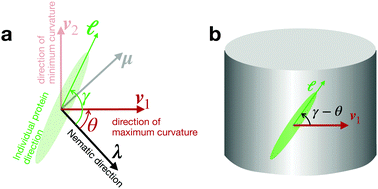A theory of ordering of elongated and curved proteins on membranes driven by density and curvature
Abstract
Cell membranes interact with a myriad of curvature-active proteins that control membrane morphology and are responsible for mechanosensation and mechanotransduction. Some of these proteins, such as those containing BAR domains, are curved and elongated, and hence may adopt different states of orientational order, from isotropic to maximize entropy to nematic as a result of crowding or to adapt to the curvature of the underlying membrane. Here, extending the classical work of Onsager for ordering in hard particle systems and that of [E. S. Nascimento et al., Phys. Rev. E, 2017, 96, 022704], we develop a mean-field density functional theory to predict the orientational order and evaluate the free energy of ensembles of elongated and curved objects on curved membranes. This theory depends on the microscopic properties of the particles and explains how a density-dependent isotropic-to-nematic transition is modified by anisotropic curvature. We also examine the coexistence of isotropic and nematic phases. This theory predicts how ordering depends on geometry but we assume here that the geometry is fixed. It also lays the ground to understand the interplay between membrane reshaping by BAR proteins and molecular order, examined by [Le Roux et al., submitted, 2020].



 Please wait while we load your content...
Please wait while we load your content...